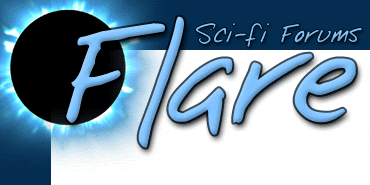I use Paint Shop Pro (PSP) and MS paint.The initial drawing (B&W, lines only) is MS-paint, although if I have to do any complex cutting and pasting, I switch to PSP for that. For example, if I have to partially hide a nacelle behind some of the ship's structure, I'll copy the view it will be in to PSP, then make a separate copy with the nacelle superimposed on top of that structure, then paste just that structure over that view, so only the parts that would be visible will show, then I paste the completed view back into MS-paint.
Once the line-drawing is complete, I save the bitmap and re-open it in PSP. I save the picture as a gif (to avoid over-writing the bitmap) and then increase the color depth to maximum (PSP won't let you do some effects unless you're at the highest color depth).
I then fill the image elements with color. Usually I use a Linear Gradient or Sunburst Gradient fill to get the shading, but sometimes I use a pattern fill.
When doing a ship with flat panels (as with the above picture), shading is kind of difficult. I select all the elements to be shaded, then deselect the lightest panels. I reduce luminance on the remaining selecttions, then deselect the next-lightest panels and repeat, until I'm done. Flat-panel designs are the easiest to draw (and the easiest to calculate what the element intersections should look like) but the hardest for me to shade. There's a lot of steps and it's easy to make a mistake.
Once the shading is complete, I select the drawing elements (without the background) and crop the selection to just the ship itself, then increase canvas size to 640x480 again, centering the drawing in the picture.
Once that's complete, I use the color substitution tool to change the (white) background to a godawful pink (actually, it's maximum red plus maximum blue, so technically, I suppose it's a godawful violet) that I never use for any other picture element. I then reduce color depth to 256 and set the background color (the aforementioned violet) to "transparent". By using a unique color, I ensure that only the background is transparent, not any part of the vessel itself (at least not the opaque parts).
That's about it.
--Baloo
------------------
"Sometimes "dark" is just a way of saying you�ve nothing to add, only a new way to subtract."
--James Lileks
http://www.geocities.com/cyrano_jones.geo/
[This message has been edited by Baloo (edited March 14, 2000).]





 Printer-friendly view of this topic
Printer-friendly view of this topic






 Printer-friendly view of this topic
Printer-friendly view of this topic